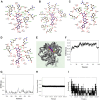Inhibitory Activity of Glycosides from Elsholtzia ciliata against Soluble Epoxide Hydrolase and Cytokines in RAW264.7 Cells
- PMID: 39682014
- PMCID: PMC11813350
- DOI: 10.4014/jmb.2410.10011
Inhibitory Activity of Glycosides from Elsholtzia ciliata against Soluble Epoxide Hydrolase and Cytokines in RAW264.7 Cells
Abstract
Soluble epoxide hydrolase (sEH) and pro-inflammatory cytokines are associated with the development of inhibitors for cardiovascular and inflammatory diseases. Here, we report on four natural sEH inhibitors isolated from the aerial parts of Elsholtzia ciliata (Thunb.) Hyl.. The four compounds, 1-4, were identified as luteolin-7-O-glucoside (1), yuanhuanin (2), apigenin-7-O-glucoside (3), and butein-4'-O-glucoside (4). Among them, compounds 2 and 4 are reported for the first time from this plant. In vitro and in silico, they showed inhibitory activity towards sEH at micromole concentrations. Moreover, they suppressed pro-inflammatory cytokines in polyinosinic:polycytidylic acid (poly(I:C))-stimulated RAW264.7 cells. Notably, 4 significantly downregulated the sEH catalytic reaction, NO and PGE2 production, and the expression levels of iNOS, COX-2, IL-6 mRNA, and sEH mRNA. Therefore, butein-4'-O-glucoside (4) is a potential sEH inhibitor that may be suitable for treating inflammation and cardiovascular diseases caused by infection.
Keywords: Elsholtzia ciliata; Lamiaceae; cytokines; glycoside; soluble epoxide hydrolase.
Conflict of interest statement
The authors have no financial conflicts of interest to declare.
Figures




References
-
- World Health Organization, author. Cardiovascular diseases(CVDs) [Accessed March 13, 2024]. Available from. https://www.who.int/news-room/fact-sheets/detail/cardiovascular-diseases...
MeSH terms
Substances
LinkOut - more resources
Full Text Sources
Research Materials
Miscellaneous

